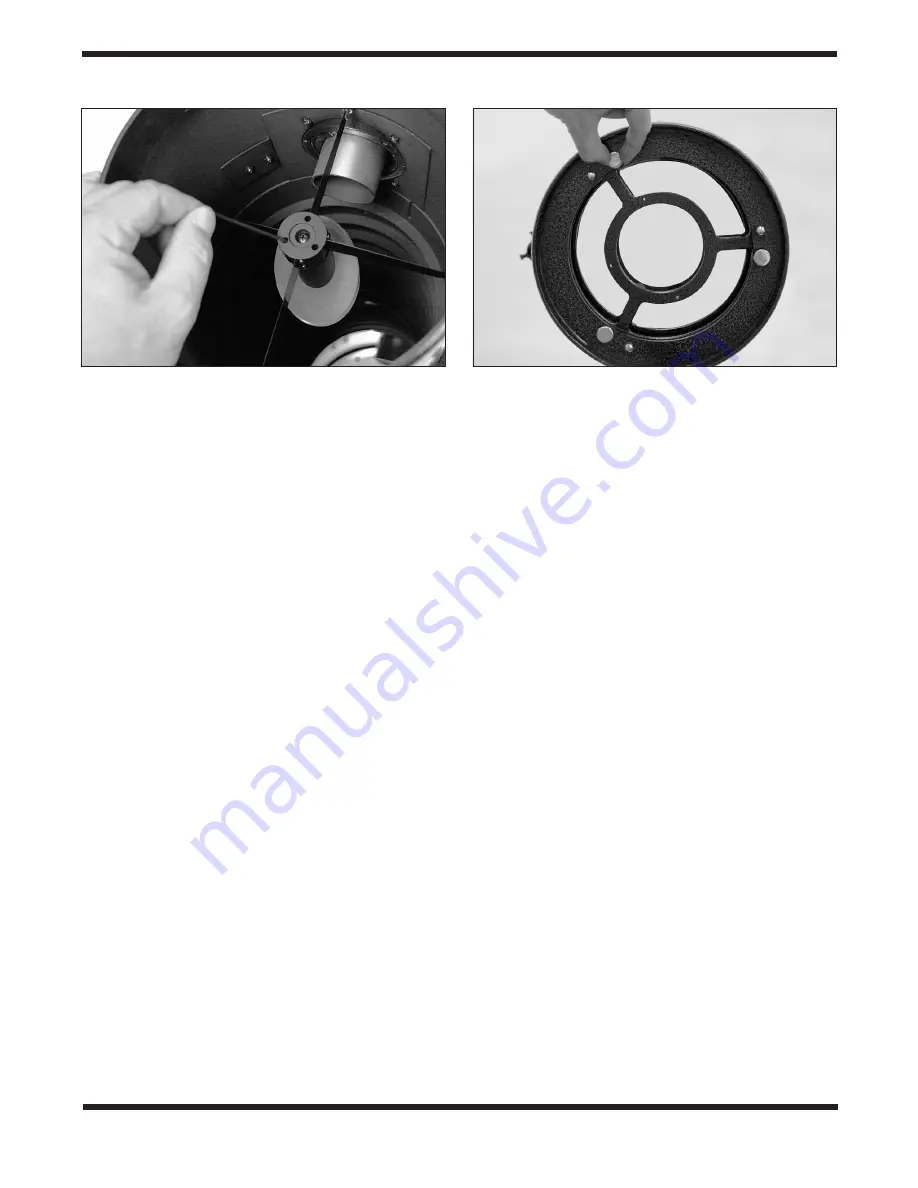
10
of the three alignment set screws by, say, one full turn, and
then tighten the other two to take up the slack
(Figure 13).
Do not loosen the center screw during this process. The goal
is to center the primary mirror reflection in the secondary mir-
ror, as in
Figure 8d. When it is centered, you’re done adjust-
ing the secondary mirror. Don’t worry that the reflection of the
secondary mirror (the dark circle with the four spider vanes
adjoining it) is off-center, since that adjustment is made when
aligning the primary mirror in the next step.
Aligning the Primary Mirror
The final collimation adjustment is made to the primary mir-
ror. It will need adjustment if, as in
Figure 8d, the secondary
mirror is centered under the focuser and the reflection of the
primary mirror is centered in the secondary mirror, but the
reflection of the secondary mirror (dark circle containing the
light reflective surface and center black “dot” of the collimation
cap) is off-center.
The tilt of the primary mirror is adjusted with three spring-
loaded collimation knobs on the back end of the optical tube
(bottom of the primary mirror cell); these are the larger knobs
(Figure 14). The other three smaller thumbscrews lock the
mirror’s position in place; these thumbscrews must be loos-
ened before any collimation adjustments can be made to the
primary mirror.
To adjust the primary mirror’s tilt, first loosen all three locking
(thin) thumbscrews by turning them counterclockwise a cou-
ple of turns each. Now, while looking into the focuser through
the collimation cap, turn one of the larger collimation knobs
a half turn or so in either direction and see if the secondary
mirror reflection moves closer to the center of the primary.
That is, does the “dot” of the collimation cap appear to move
closer to the ring on the center of the primary mirror? If it
does, great, keep going until you get it as close as you can.
If it doesn’t, try turning the collimation knob in the opposite
direction. If turning the one knob does not seem to bring the
dot closer to the ring, try using one of the other collimation
knobs. It will take some trial-and-error using all three collima-
tion knobs to properly align the primary mirror. Over time you
will get the feel for which collimation knobs to turn to move
the image in a given direction.
When you have the dot centered as much as possible in the
ring, your primary mirror is collimated. Now lightly tighten the
three locking thumbscrews to secure the primary mirror in
place.
The view through the collimation cap should now resemble
Figure 8e. A simple star test will indicate how well the tele-
scope optics are collimated.
Star-Testing the Telescope
When it is dark, point the telescope at a bright star and accu-
rately center it in the eyepiece’s field of view. (To achieve
focus with an eyepiece, you will likely have to use the included
35mm extension adapter, as described previously.) Slowly
de-focus the image with the focusing knob. If the telescope is
correctly collimated, the expanding disk should be a perfect
circle
(Figure 15). If the image is unsymmetrical, the scope
is out of collimation. The dark shadow cast by the second-
ary mirror should appear in the very center of the out-of-focus
circle, like the hole in a donut. If the “hole” appears off-center,
the telescope is out of collimation.
If you try the star test and the bright star you have selected is
not accurately centered in the eyepiece, the optics will always
appear out of collimation, even though they may be perfectly
aligned. It is critical to keep the star centered, so over time
you will need to make slight corrections to the telescope’s
position in order to account for the sky’s apparent motion.
Point the telescope at Polaris (the north star) if you do not
have a mount that tracks.
3. Care & Maintenance
Give your telescope reasonable care and it will last a lifetime.
When not in use, keep its dust cover on as well as the dust
Figure 14.
The tilt of the primary mirror is adjusted by turning
one or more of the three large, spring-loaded collimation knobs. The
three thinner thumbscrews lock the primary mirror in place.
Figure 13.
The tilt of the secondary mirror is adjusted with a
2mm Allen wrench on the three setscrews surrounding the center
Phillips-head bolt.



























